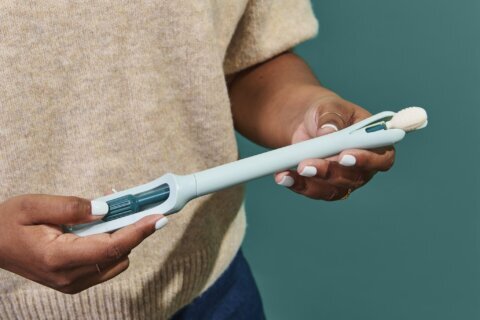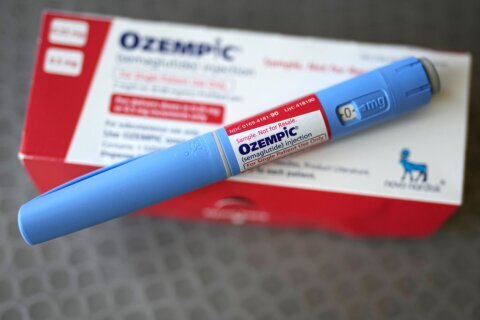A blood clot can be a serious medical problem. It can even lead to a heart attack, stroke or death. In fact, 274 people die every day from blood clots, according to the National Blood Clot Alliance.
So what does a blood clot look or feel like? And how do you know if you have one?
A blood clot is a gel-like collection of blood cells in the veins or arteries that blocks blood flow. Without proper blood flow, important parts of your body like the heart, brain and legs may not get the oxygen they need. Blood clots can be as small as a grain of rice or as long as a Polish kielbasa, says Dr. Lawrence “Rusty” Hofmann, a professor of interventional radiology at Stanford University Medical Center in Palo Alto, California.
Types of Blood Clots
Millions of years ago, blood clots helped stop humans from bleeding to death after they were bitten by saber-tooth tigers, Hofmann explains. Nowadays, blood clots can still be helpful if we get injured, but they also can form for other reasons, which can be harmful.
The three types of venous blood clots are:
1. Superficial thrombophlebitis. This is the least serious type of blood clot. It forms in a vein near the skin’s surface. Although it’s less harmful, this type of clot should still be checked out by a doctor as it sometimes leads to deep vein thrombosis.
2. Deep vein thrombosis. Also called DVT, this type of blood clot occurs when a clot forms deep inside a vein, usually in the arms or legs.
3. Pulmonary embolism.
In discussions of blood clots, you might also hear the term arterial clots. These are different conditions with different implications depending on where they occur.
What worries doctors the most is when a blood clot in one part of your body — say, your leg — dislodges and travels to the brain, heart or lungs, says Dr. Nicole Weinberg, a cardiologist at Providence Saint John’s Health Center in Santa Monica, California.
In the lungs, a blood clot can cause what’s called a pulmonary embolism. According to the Centers for Disease Control and Prevention, 25% of people with a pulmonary embolism die without warning. Pulmonary embolisms are the leading cause of death in those with cancer, aside the cancer itself.
[Read: Exercising Safely After Having a Blood Clot.]
Risk Factors for a Blood Clot
There are several risk factors that put someone at a higher risk for a blood clot, including the following:
— You’re pregnant.
— You use birth control pills or hormone therapy.
— You’re obese.
— You smoke.
— You have diabetes.
— You’re over the age of 60.
— You’re inactive for a long time. For example, you have a sedentary lifestyle, or you’re resting at home after surgery.
— You’ve had orthopedic surgery.
— You have or recently had COVID-19.
— You’re traveling for a long time in a plane, car or train, and you’re not able to move around much.
— You have certain blood disorders, such as Factor V Leiden, that make you more prone to clotting.
— You have the autoimmune disorder antiphospholipid syndrome or lupus.
— You have cancer.
Doctors usually believe that two factors often come together to increase the risk for blood clotting, says Dr. Jack F. Jacoub, an internist, hematologist and medical oncologist with MemorialCare Cancer Institute at Orange Coast Medical Center in Fountain Valley, California.
For example, you have cancer, and you’re on treatment and doing well. You decide with your family to travel to Hawaii. The combination of having cancer and taking a long trip may increase your risk, Jacoub says.
Another example: You’re a young woman who’s pregnant, and you’re on a long business trip. “All of the sudden you could be dealing with a really big crisis in someone who’s supposed to be healthy,” Weinberg says.
Researchers are still exploring the link between COVID-19 and blood clots and whether there’s a continued blood clot risk for a certain time period after having the virus. One thing they do know is that COVID-19 can directly affect blood vessels, and that increases the risk of blood clots, says Dr. Ian Del Conde-Pozzi, a cardiologist and vascular medicine specialist with Baptist Health’s Miami Cardiac & Vascular Institute.
[READ: Exercise and Virtual Reality.]
Symptoms of a Blood Clot
Blood clots can have several symptoms, although sometimes they’re not obvious. The symptoms may vary depending on where the blood clot is located. They can come on suddenly and then get worse fairly quickly.
For deep vein thrombosis, symptoms at the site of the clot include:
— Redness.
— Warmth at the skin.
— Pain that’s not caused by an injury.
— Swelling.
— A cramp-like or charley horse feeling.
For a pulmonary embolism, symptoms include:
— Unexplained shortness of breath.
— An unexplained cough.
— A faster heart rate.
— Chest pain.
— Feeling fatigued or not like yourself.
You have to stay aware of how serious these symptoms can be. “It’s important, especially in young, healthy patients who don’t think of themselves at risk,” says Dr. Danielle R. Bajakian, an assistant professor of surgery with Columbia University Medical Center in New York.
She’s seen several young adults with blood clots in their legs, and they assumed their symptoms were from working too hard at the gym. They ignored the symptoms until they went from mildly annoying to extremely serious or painful.
It’s especially important to seek medical attention quickly for a suspected blood clot if you’ve recently taken a long trip, Jacoub says.
Blood Clots and COVID-19 Vaccines
A rare type of blood clot sometimes forms in those having the Johnson & Johnson COVID-19 vaccine. This risk is not associated with the Pfizer-BioNTech or Moderna vaccine. The AstraZeneca vaccine also has been associated with a blood clotting risk but is not currently available in the U.S.
Called vaccine-induced thrombotic thrombocytopenia or thrombosis with thrombocytopenia syndrome, these rare blood clots occurred in 28 people after 8.7 million doses of the Johnson & Johnson vaccine were given in the U.S. through mid-May 2021. As of mid-May, three people had died from the blood clots. Those who have experienced these blood clots tend to be under age 50 and female.
The cause of these clots is different from the other types of clots typically seen in medicine, Del Conde-Pozzi says. The clots appear to be related to an immune reaction where antibodies, or proteins that help fight invaders to the body, develop against a type of blood protein called platelet factor 4. People with the clots also have low counts of a type of blood clotting cell called platelets. The blood clots that occur happen in less common areas of the body, such as the veins in the brain or veins in the abdomen.
It may be that the delivery systems used in these vaccines cause this abnormal clotting, says Dr. Aloke Finn, an interventional cardiologist and associate professor of medicine at the University of Maryland School of Medicine in Baltimore.
The symptoms of the vaccine-related blood clot are similar to other blood clots and include:
— A bad headache.
— Bleeding.
— Leg swelling.
— Shortness of breath.
— Significant abdominal pain.
The symptoms will occur within five days to a month after receiving the vaccine. Symptoms that occur within a day or two after your vaccine, such as a fever, fatigue or mild headache, are normal and don’t indicate this rare blood clot, Finn says.
As with other blood clots, you should go to the emergency room if you have these symptoms. Let those treating you know if you had the Johnson & Johnson vaccine. Treatment will usually include a specific type of blood thinner, high doses of a treatment called intravenous immunoglobulin and steroids in some cases.
While it’s always a good idea to talk with your doctor about the best vaccine for you, the benefit of the vaccine generally outweighs the risks, Del Conde-Pozzi says. For instance, the Johnson & Johnson vaccine is one dose, and that could be easier for some people. Plus, the incidence of this rare type of blood clot is still low compared with the number of doses given throughout the U.S.
Treatment for Blood Clots
If you suspect you or someone you’re with has a blood clot, seek medical attention right away. If your symptoms happen on a Friday night, don’t wait until Monday morning to call your doctor. Go to the ER. Even some urgent care offices have the technology to diagnose a blood clot.
The two major treatments for blood clots are medicines or the use of special devices, such as wires and catheters, to help open the blood vessels, Hofmann says. Blood thinners are the most common type of medicine used to treat blood clots. The medicines used may be given orally or through an IV. Doctors might perform a surgical procedure called a thrombectomy to try to remove a clot.
For heart attacks or strokes related to a blood clot, you may receive thrombolytic therapy. This involves the use of drugs that can help break up the clot. Breaking up the clot is needed so you no longer have the clot blocking blood flow.
The treatments for blood clots are generally effective. However, more serious blood clots can lead to death, even once a patient is in the emergency room, Jacoub says. That can happen because a person may not get to the ER quickly enough.
“The smaller the clot is, the more you can prevent further destruction,” Weinberg says.
For people who have chronic problems with blood clots, there are special stents — a tiny tube inserted into the blood vessel to help keep it open — available to help them, Hofmann says.
[SEE: How to Describe Medical Symptoms to Your Doctor.]
Blood Clot Prevention
There are some things you can do to lower your risk for blood clots.
1. Know your risk.
Talk to your doctor about your risk for blot clots. If you’re at a higher risk and about to do something that will increase the chances of a blood clot forming — for example, take a long flight — your doctor may recommend that you use blood thinners in advance to lower your risk. A long flight can be eight hours or more, but you still would want to stay active on a flight that’s three hours or more.
2. Before a major surgery or hospital stay, ask your doctor what they’ll do to lower your risk for blood clots.
For instance, patients who have been in the hospital for three or four days or who have certain orthopedic procedures like hip replacement surgery typically receive blood thinners to reduce their clotting risk, Del Conde- Pozzi says.
One drawback of blood thinners is they could cause increased bleeding, although the medications continue to improve in this area, Finn says. Your doctor will weigh the risks and benefits of prescribing a blood thinner as needed, he adds.
3. Aim for overall healthy habits.
Stay physically active and don’t smoke. The increased risk of blood clots is yet another reason to quit the smoking habit, Bajakian says.
4. Work with your health care providers to get back on your feet promptly after surgery.
This will help you not be too sedentary, which could increase your risk for blood clots.
5. If you sit a lot with your job, get up every hour or two to walk around or stretch.
6. Keep any chronic health conditions, such as diabetes or high blood pressure, under control.
7. Take special precautions when you’re on a long trip.
Stay hydrated by drinking lots of water and avoiding alcohol. Consider wearing compression stockings, which are used around the legs to help prevent vein disorders. These types of stockings are designed to lengthen the calf and help blood flow out of the legs and back to the heart.
Get up and walk every hour or so. If that’s not possible — we hear you, window seat traveler — you can still do some simple exercises to keep your calves active.
Hofmann recommends pushing your toes down and then lifting your heels off the ground. Do this 20 times every hour. To help stay active and reduce the risk for blood clots, passengers on a 2019 flight on Qantas Airlines from New York to Sydney, Australia, did the “Macarena” around the plane to keep moving, according to news reports.
By taking steps to cut your risk of blood clots, you can help prevent a serious health issue.
More from U.S. News
9 Reasons You Should Return to Work After a Stroke
Questions Doctors Wish Their Patients Would Ask
7 Ways to Prevent Medical Errors
What Are the Warning Signs of a Blood Clot? originally appeared on usnews.com
Update 08/06/21: This piece was previously published at an earlier date and has been updated with new information.







